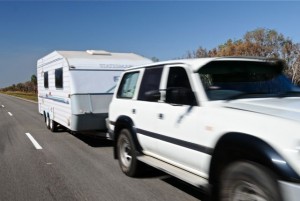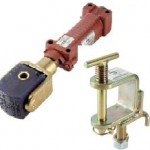 Your “vehicle connections” between your car and the camper or trailer need to be taken seriously to avoid problems that can be easily avoided!
Your “vehicle connections” between your car and the camper or trailer need to be taken seriously to avoid problems that can be easily avoided!
There are many reasons why you need to pay careful attention to the coupling and other towing connections between your car and trailer, non more so than SAFETY! In relation to vehicle connections, the SEVEN MOST IMPORTANT things you need to be aware of and set up for are these:
- Type of towball/hitch on camper
- Height of camper trailer/caravan when in tow
- Weight of camper trailer at tow ball
- Electrical plug connection
- Jockey wheel
- Spare towball/tow hitch
- Weight of camper trailer/caravan
You will be familiar with the standard “towball” type trailer  hitch, but make sure you find out if it is the same on the camper trailer you are purchasing as they come in different sizes. The towing hitch on your car needs to match the hitch on the camper. There are also different hitches and if you are buying a camper with Trigg Bros hitch, you will need to have 2 towing bars. Why?
hitch, but make sure you find out if it is the same on the camper trailer you are purchasing as they come in different sizes. The towing hitch on your car needs to match the hitch on the camper. There are also different hitches and if you are buying a camper with Trigg Bros hitch, you will need to have 2 towing bars. Why?  The Trigg Bros setup doesn’t allow the use of a tow ball. Due to this difference, you will be wise to have an interchangeable setup that allows the Trigg hitch for towing the camper and another common tow ball hitch in case you need a trailer to run to the rubbish tip etc.
The Trigg Bros setup doesn’t allow the use of a tow ball. Due to this difference, you will be wise to have an interchangeable setup that allows the Trigg hitch for towing the camper and another common tow ball hitch in case you need a trailer to run to the rubbish tip etc.
The weight of the camper trailer and your towing vehicle’s suspension will determine whether the tail end of the car drags on the ground. You need to make sure your car is rated to take the weight of the camper at the tow ball, and has the capacity to pull the camper on or off road as the case may be. If the camper is too heavy or your car is too low which causes the camper to sit down too far at the front when being towed, then you may need to visit Pedders or a Suspension shop and beef up your rear springs, or fit pump up shock absorbers. Make sure the car and the camper sit level when loaded onto the car’s towbar.
Check the electrical plug on the camper to see if it matches the one on you car. If it doesn’t you can buy these items at SupaCheap Auto and fit them yourself. Better idea is to have an Auto Electrician fit the electrical plug the same time they fit the Electric Brake Controller*. That’s right, you will need an electric brake controller if your:
- camper trailer/caravan has electric brakes fitted;
- camper trailer weighs more than 759kgs
- car is undersized to the camper (eg: Suzuki Vitara or Holden Commodore towing a Jayco Expanda or Swan)
Does your camper have a “Jockey Wheel”? That’s the wheel at the front of the camper near the tow hitch that either detaches or swings away. It’s common for people to forget to remove the Jockey Wheel when hitching the camper to the car. While they are essential to carry the weight of the camper when detached from the car and allow easy coupling of camper to tow hitch, they must be removed once hitched up. Write this down!
If you cant release the trailer from the towball or the pin from the hitch block, there are some things you can do to prevent “sticking” or “failed release”. A towball coupling traditionally needs to be greased or lubricated. For this purpose apply a typical mechanical bearing grease. When not in use, cover the towball to prevent dirt sticking to the greased ball and causing excessive wear or failed release when with the trailer. You may have seen some vehicles with a tennis ball over their towball. These are a cheap solution for keeping your towball in a clean and ready state. It also helps prevent rusting. The trailer hitch should be sprayed with a Lanotec (lanolin lubricant/protectant) or WD-40, and even wrapped in a plastic bag if the trailer is stored outside. Keeping this part of the trailer from rusting is your primary aim. Before hitching the trailer to the towball, wipe the ‘female’ part on the trailer with a rag to clean out any contaminants that may foul the coupling. This coupling should operate smoothly. When tightening the locking nut, you shouldn’t need to use excessive force. If you do, its time to lubricate the parts and inspect the coupling for wear & tear or damage.
 There are many other types of camper trailer couplings available. More common is the “Trigg Bros Hitch” in the photo right. It operates differently to the traditional towball in that, this coupling has a nylon bock with a brass bush (hollow tube) through the middle. The brass bush being softer metal than the pin, will eventually wear, but will wear more rapidly with the abrasive effect of dirt inside the bush. Often on long trips dirt in the coupling is unavoidable, however proper maintenance should be applied to ensure the pin doesn’t get stuck in the bush or the split pin that secures the main ‘coupling pin’ isn’t damaged or compromised in any way. By applying a ‘dry’ lubricant such as graphite powder to the inside of the bush and pin will deter larger dirt particles from entering and provide appropriate lubrication to the bush and pin under load conditions. It will also prevent the pin from sticking when attempting to remove the trailer from the vehicle.
There are many other types of camper trailer couplings available. More common is the “Trigg Bros Hitch” in the photo right. It operates differently to the traditional towball in that, this coupling has a nylon bock with a brass bush (hollow tube) through the middle. The brass bush being softer metal than the pin, will eventually wear, but will wear more rapidly with the abrasive effect of dirt inside the bush. Often on long trips dirt in the coupling is unavoidable, however proper maintenance should be applied to ensure the pin doesn’t get stuck in the bush or the split pin that secures the main ‘coupling pin’ isn’t damaged or compromised in any way. By applying a ‘dry’ lubricant such as graphite powder to the inside of the bush and pin will deter larger dirt particles from entering and provide appropriate lubrication to the bush and pin under load conditions. It will also prevent the pin from sticking when attempting to remove the trailer from the vehicle.
This covers the seven most important things to be aware of. Now you just need to get used to towing a vehicle behind your car. It can be very dangerous if you are not familiar with the way the car handles under load. There’s also a learned skill to reversing too. Most importantly, Stay SAFE and get your set up inspected by a mechanic or even trailer hire place like Kenards Hire, if you are lacking experience in this area. Safety should always come first when towing.
 *Note: There are a few different brands of brake controllers, they are all pretty much the size of cigarette packet and sit under your dash in next to your console. they have an up and down adjustment that sets the amount of braking force on the trailer so that when your car brakes are applied, the trailer brakes are applied at the same rate. Get them fitted before you collect the camper from the seller.
*Note: There are a few different brands of brake controllers, they are all pretty much the size of cigarette packet and sit under your dash in next to your console. they have an up and down adjustment that sets the amount of braking force on the trailer so that when your car brakes are applied, the trailer brakes are applied at the same rate. Get them fitted before you collect the camper from the seller.
Here’s a link to further information on HOW TO TOW A TRAILER (its from the US, but very detailed and informative)
CLICK HERE to subscribe to our free newsletter.












